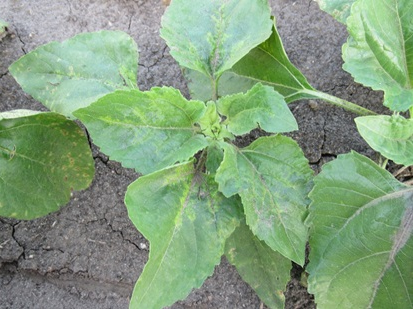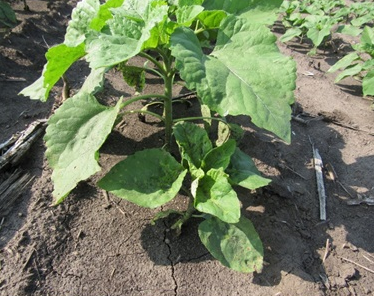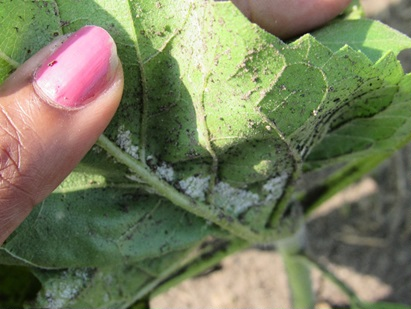Source: South Dakota State University
By Febina Mathew, Oilseeds Plant Pathologist
Downy mildew is one of the most common diseases that can affect sunflowers early in the season. It is present in areas with poor drainage, where water can collect and spores of the causal pathogen (Plasmopara halstedii) can swim and infect the plants.
Yield losses can be substantial depending on the percentage of infected plants and their distribution within the sunflower field.
In South Dakota, given the cool, wet weather in June, we are seeing downy mildew develop in a few sunflower fields. However, the infected plants are scattered randomly in these affected fields and yield losses will be minimal, if they occur at all.
Typically, downy mildew develops as a systemic infection caused by the pathogen early in the season. The spores enter the sunflower’s roots and invade the rest of plant, causing chlorosis (yellowing) on the upper side of the leaves (Figure 1).

Figure 1. Chlorosis (yellowing) on the upper side of the leaves from downy mildew infection.
White, cottony masses (mycelium) appear on the underside of the infected leaves (Figure 2). Sunflower plants may appear stunted and will produce little or no seed (Figure 3).
Delayed or secondary infections from the downy mildew pathogen can also occur on sunflower plants when zoospores are windblown from an infected plant onto the leaves of a nearby plant.
However, secondary infections are not economically important and if the infection occurs, the sunflowers will “grow out” of the disease.
To manage downy mildew in sunflower, consider using resistant/tolerant hybrids and fungicide seed treatments. For information on fungicide seed treatments for sunflowers, refer to the 2015 South Dakota Pest Management Guide for Alfalfa and Oilseeds.

Fig. 3. Plants may appear stunted (notice differences in height between healthy plant and systemically infected plant) from downy mildew infection.

Fig. 2. White cottony masses (mycelium) on the underside of infected leaves.
Foliar fungicide sprays are ineffective and not recommended. Although crop rotation is important for management of other sunflower diseases such as Sclerotinia stalk rot, sunflower rust and Phomopsis stem canker, it may not help manage downy mildew given the overwintering spores (oospores) of the causal pathogen can survive in the soil up to 10 years.
More Information
For more downy mildew management information, visit the National Sunflower Association’s Downy Mildew website.






Post a comment
Report Abusive Comment